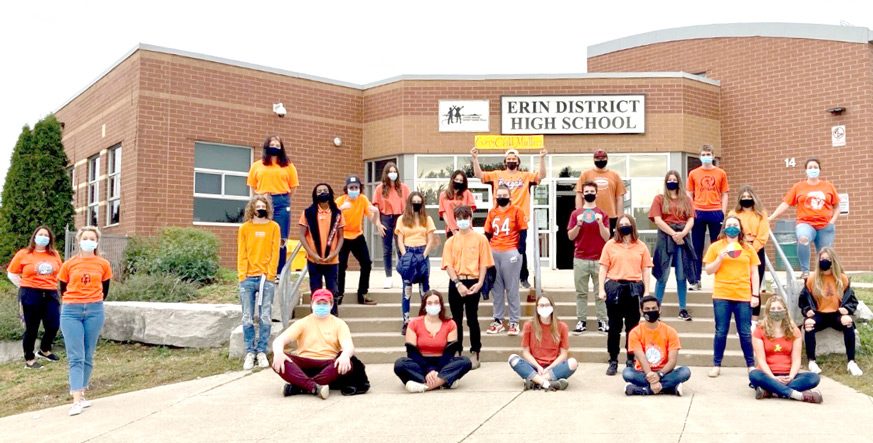ERIN – Students at Erin District High School (EDHS) are among those who will participate in Orange Shirt Day, which aims to recognize the abuse Indigenous people endured in residential schools and promote conversations of reconciliation.
Each EDHS student will share a message of kindness or a fact they’ve learned about Indigenous history written on an orange paper shirt to be displayed in the front hall of the school.
Sept. 30, known as Orange Shirt Day, is an Indigenous-led commemorative day that honours children who survived residential schools and remembers those who didn’t.
The day recognizes the experience of Phyllis Webstad, a Northern Secwpemc (Shuswap) from the Stswecem’c Xgat’tem First Nation, who wore a new orange shirt on her first day of school and had it taken from her.
The orange shirt is now “a symbol of the stripping away of culture, freedom and self-esteem experienced by Indigenous children over generations,” states a Government of Canada website dedicated to the day.
On Sept. 30, Canadians are encouraged to wear orange to raise awareness of the tragic legacy of residential schools and to honour the thousands of survivors.
This year, Sept. 30 will also mark the first National Day for Truth and Reconciliation, a day honouring the lost children and survivors of residential schools, their families and communities.
Ashley Gibson, english department lead at EDHS, said this is the first year the school has every student participating in Orange Shirt Day.
“Our goal as a whole is to be proactive instead of reactive. How are we going to be the catalyst for change? Because we know how easy it is to acknowledge something and then move on from it and not really change anything,” she explained.
At EDHS, Grade 11 students are required to take a contemporary Indigenous voices course and in previous years, students in that class would do something to commemorate the day.
But this year, “Every student at our school will write a fact about residential schools,” said Gibson.
“Our social justice committee created a lesson that every teacher will deliver on Sept. 30th before the students write on the shirts,” Gibson explained.
“Every student will write a message of kindness or a statistic that they’ve learned; something that has a significant importance to the day and the event.”
She added there should be about 500 “shirts” displayed.
Gibson said the idea to display cut-out shirts in the front of the school came after conversations with the school’s social justice committee.
“That’s where it started last year and this year, we thought it has to be bigger than just one classroom, it has to be an entire school initiative so every class will be receiving the shirts and there’s one shirt per student in our school,” she explained.
Gibson said in the week leading up to Sept. 30, students were to participate in various learning exercises in addition to acknowledging unmarked graves being revealed at previous residential school lands.
“I think the big question surrounding Orange Shirt Day and just anything regarding the truth and reconciliation and the 94 calls to action the question is – what type of change do you want to bring?”
She said each student at EDHS participated in various activities that discussed the Truth and Reconciliation Commission and addressed the 94 Calls to Action.
Gibson said she hopes students will take the time to stop and reflect.
“I think if we are going to talk about awareness around Orange Shirt Day it’s not just a performative day just to say we acknowledged it and then move on, I want it to have a lasting impact and I want every student to actually have to stop and think about it,” she said.
“I know it takes a lot of time so if every year we can just grow with provided information and reach more people and touch more lives then I think that’s our goal – education that has an impact.”
Mars Gagawchuk, social justice committee student representative at EDHS, said an important part of having these conversations at school is to ensure students are properly informed, adding it’s crucial for students to learn at an early age.
“They were children just like we were once, so us understanding the struggles that Indigenous people had to face and continually face now is really important because it could’ve been us, it could’ve been anybody,” said Gagawchuk.
“From this experience we’ve learned that there’s a lot of kids who are actually interested in learning what’s happening,” added EDHS Indigenous student representative Danaca Marier.
“They just never really had the support in their school or beforehand; a lot of schools didn’t really talk about this, so a lot of kids didn’t really notice that it was an issue.
“But this year at our school we’re really trying to get the information to students, and you can see that they’re actually really excited to learn about it.”
Marier added it makes her really happy knowing the school is so open and has teachers like Gibson willing to teach students.
Gagawchuk said it’s also important to have open conversation and ensure students feel comfortable asking questions, which she said also includes having an open mind.
“I think students may be a little scared to ask questions about it and are afraid to admit they don’t know it’s happening,” she said.
“So with students coming in with this open mind and just feeling free enough to ask questions to the teachers and be more vulnerable I think it’s really important.”
Gagawchuk added, “No one’s going to shame you for not knowing.
“It’s just about understanding that this actually happened and taking steps to be better people and being advocates and allies for Indigenous people in our communities and schools.”
Workplaces and organizations are also encouraged to participate by wearing orange shirts on Sept. 30.




